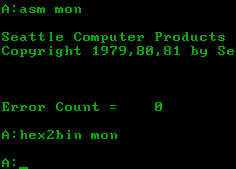86-DOS

A sample 86-DOS session (simulated).
|
|
| Developer | Seattle Computer Products / Tim Paterson |
|---|---|
| Written in | 8086-Assembly language |
| OS family | DOS |
| Working state | Historic, Unsupported |
| Source model | Closed source |
| Initial release | 1980 |
| Latest release | 86-DOS 1.10 / July 1981 |
| Marketing target | S-100-based micro-computers with 8086 processor |
| Available in | English |
| Package manager | N/A |
| Platforms | x86 |
| Kernel type | Monolithic kernel |
| Default user interface | Command line interface |
| License | Proprietary |
86-DOS is a discontinued operating system developed and marketed by Seattle Computer Products (SCP) for its Intel 8086-based computer kit. Initially known as QDOS (Quick and Dirty Operating System) the name was changed to 86-DOS once SCP started licensing the operating system in 1980.
86-DOS had a command structure and application programming interface that imitated that of Digital Research's CP/M operating system, which made it easy to port programs from the latter. The system was purchased by Microsoft and developed further as MS-DOS and PC DOS.
86-DOS was created because sales of the Seattle Computer Products 8086 computer kit, demonstrated in June 1979 and shipped in November, were languishing due to the absence of an operating system. The only software which SCP could sell with the board was Microsoft's Standalone Disk BASIC-86, which Microsoft had developed on a prototype of SCP's hardware. SCP wanted to offer the 8086-version of CP/M that Digital Research had announced, but its release date was uncertain. This was not the first time Digital Research had lagged behind hardware developments; two years earlier it had been slow to adapt CP/M for new floppy disk formats and hard disks. In April 1980 SCP assigned 24-year-old Tim Paterson to develop a substitute for CP/M-86.
Using a CP/M-80 manual as reference Paterson modeled 86-DOS after its architecture and interfaces, but adapted to meet the requirements of Intel's 8086 16-bit processor, for easy (and partially automated) source-level translatability of the many existing 8-bit CP/M programs; porting them to either DOS or CP/M-86 was about equally difficult. At the same time he made a number of changes and enhancements to address what he saw as CP/M's shortcomings. CP/M cached file system information in memory for speed, but this required a user to force an update to a disk before removing it; if the user forgot, the disk would be corrupt. Paterson took the safer but slower approach of updating the disk with each operation. CP/M's PIP command, which copied files, supported several special file names that referred to hardware devices such as printers and communication ports. Paterson built these names into the operating system as device files so that any program could use them. He gave his copying program the more intuitive name COPY. Rather than implementing CP/M's file system, he drew on Microsoft Standalone Disk BASIC-86's FAT filesystem.
...
Wikipedia
